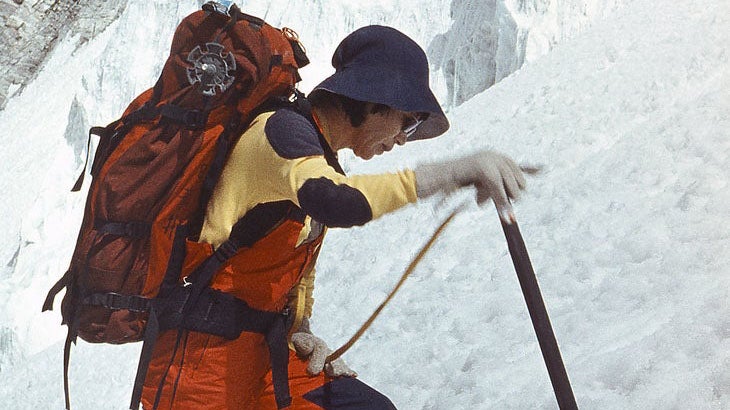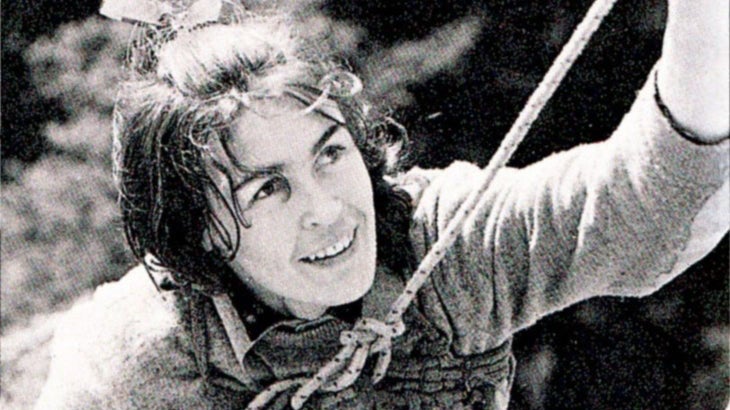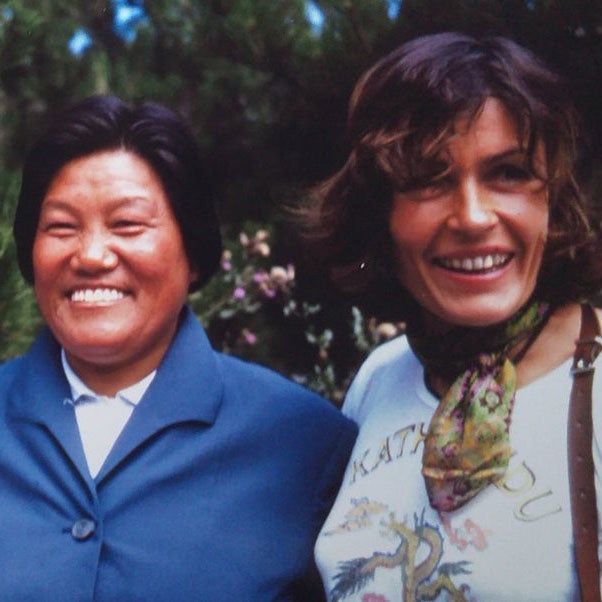This photo captures a moment that will never come again: a gathering of the first three women to climb Mount Everest. Together, smiling. All are now gone.
Taken by Isabelle Agresti, a French climber, the image is from August 1979 in Chamonix. Junko Tabei of Japan, Phanthog of Tibet, and Wanda Rutkiewicz of Poland were invited that summer by Henri Agresti, a guide at ENSA (L’École Nationale de Ski et d’Alpinisme) who was teaching a class to aspiring mountaineers.��In 1976 Henri and Isabelle had been part of a team to establish a new route up Mount Foraker, in Denali National Park, and the two made the first ascent of the mountain Koh-e-Rank in the Hindu Kush, Afghanistan, in 1968.
The visiting women spoke consecutively over three evenings.
“This picture shows one of the best hours, de fragile bonheur,” says Henri Agresti.
Tabei, a piano teacher and later author and conservationist who climbed 29,032-foot Everest on May 17, 1975, was born in Japan into postwar poverty. Small and frail like many of her generation, she was never to grow taller than four foot nine. Still she resisted the label of “weak” and at age ten joined a school trip to hike up a volcano, a life-changing event.
She also had to brave the public opinion of her era, which was that mothers should stay home and care for their families, and women were physically unable to climb at altitude.
Tabei was 35 and mother to a three-year-old, whom her husband cared for at home (they later had another child), when she climbed Everest. While Everest is her signature, she went on to climb, according to her, 13 peaks over 7,000 meters. She also reached the tallest mountain in what is variously given as some 60 or 70 countries—either way, a grand adventure and equally impressive logistically. She became an activist, cleaning up on Everest and helping victims of the 2011 earthquake and tsunami in her home country. Tabei, who inspired a generation of girls and women, was mourned the world over when she .

Her memoir, , was published in English in 2017. In a review on the American Alpine Club’s website, Shannon O’Donoghue Child wrote of Tabei’s “endearing … recurring acknowledgment and appreciation of those around her, including her husband, whose unwavering support was remarkable for that time, as well as other women climbers.”
Almost unknown—though it might easily have been otherwise—to today’s climbers is Phanthog (also known as Phantog and, in Chinese, Pan Duo), who climbed the mountain only 11 days later, the first woman to do so from its Tibetan side. Born into a poor rural Tibetan family, she went into manual labor at age eight, upon the death of her father, to help her mother support the family.
“I had to carry 30 to 35 kilograms [66 to 77 pounds] of goods over winding Himalayan roads for more than ten hours every day when I was 13,” she told .
At 20, working in a factory, she was chosen for the Chinese Mountaineering Team on the basis of her physical condition and strength. She climbed 24,636-foot Muztagh Ata in the Pamirs in 1959.
On Everest, she was 37 and had three children. According to cctv.com, she said of the final push, “At that time, I made up my mind to reach the top. I did it on behalf of my 400 million Chinese sisters to prove that we women could do the same as our male companions.”
At the summit she took a seven-minute EKG, with no unusual results.
She was quoted in �����ԹϺ��� Online��as saying, “Chinese women have a strong will; difficulties can’t stop us. We climbed the highest peak in the world; we really hold up half the sky.”
After the climb she lost three toes to frostbite.
In the years after the climb, she was elected five times as delegate to the National People’s Congress. She moved with her husband to his home city of Wuxi, Jiangsu Province, China, and worked as deputy director of its Sports and Physical Culture Commission. The Beijing Review in 1986 quoted her as saying, “I still miss the mountains that tower above my native Tibet.” She carried the Olympic flag into the stadium at the Beijing Olympics in 2008. The following year, at age 70, she was honored at the 60 Years, 60 Legends ceremony in the National Olympic Sports Center in Beijing. She died in 2014 at 75 of causes related to diabetes.
The great Polish climber Wanda Rutkiewicz became the third woman and first Pole, male or female, to climb Everest, on October 16, 1978. She was 35 then, and ten years later she became the first woman to climb K2. She summitted eight of the world’s 14�� before her death on Kanchenjunga in 1992. Had she climbed it, she would have been the first woman up the three highest mountains in the world. She was 49.
In 1974 Rutkiewicz had been in the Pamirs of the USSR to climb Communism Peak when she took a helicopter over to the base camp for an international gathering of climbers. There she met of Berkeley, California, to talk about organizing a women’s expedition together. Frustrated by unequal treatment on an early male-dominated expedition, she was to lead several all-women’s trips (Blum was to lead a women’s ascent of Annapurna in 1978). Rutkiewicz, Krystyna Palmowska, and Anna Czerwinska climbed Nanga Parbat in 1985, the first women’s team to do so; Liliane Barrard of France had been the first woman to climb it, with her husband, Maurice, the year before. Rutkiewicz was with the Barrards on K2, waiting for them on the summit. The couple were killed on the descent.
On Kanchenjunga, Rutkiewicz climbed with the Mexican mountaineer Carlos Carsolio. According to Everesthistory.com, the two started at 3:30 a.m. from camp at 7,950 meters, and Carsolio reached the top after some 12 hours in deep snow. Descending, he entered the small cave where Rutkiewicz was, at about 8,200 or 8,300 meters, and spoke with her. She said she intended to bivouac and try for the top the next day.
He told����“I��could not tell her not to go up. Not directly. I told her,��Wanda, it’s too cold, it takes time, bad weather is coming,��but I did not tell her,��Wanda, stop, come down with me. I did not have the courage to stop her dream. I knew that even if she was risking her life, it was her decision.”
He descended further and waited for two days, but she never returned nor was ever found.
She was a driven person, blunt and demanding of herself and others, yet at other times warm and humorous. As Agata Szostkowska, daughter of a woman film editor in Poland, wrote in Communications-Unlimited��(of Eastern Europe), “My mother and I remember her as a very kind and polite woman. And very warm.”
In Savage Summit: The True Stories of the First Five Women to Climb K2,��Jennifer Jordan quotes Rutkiewicz saying after K2: “It was sheer ecstasy being on the summit.”

In a several-hour interview with Jon Waterman for Climbing magazine in 1989, Rutkiewicz, a computer engineer and filmmaker who lived in Warsaw, was impassioned and animated. She joked that she had been married “two and a half times,” saying about the half, “He didn’t really count.” It was in that interview that she said, again with humor, this widely quoted line about the dangers of frostbite, contrasting Americans’ unwillingness to that of her compatriots:
“Why not [risk it]? Each climber loses one finger or toe once in a while.
“At Kukuczka’s house there was a meeting of many climbers and they said [pointing to missing fingers and toes], ‘Oh, you have not this, you have not this, you have not this?’ This is a small but important reason for Polish climbers’ success. Western climbers haven’t lost [as many] fingers or toes.”
Waterman recalls, “She was super charming in person. A beautiful, strong woman.”
The Himalayan historian Elizabeth Hawley wrote in the , “Wanda Rutkiewicz will go down in history as one of the greats of mountaineering.”
See ��and��our .
They include Marty Hoey, a climber and Snowbird, Utah, ski patroller who would probably have been the first American woman on the summit if not for a disaster up high, and Stacy Allison, a Portland, Oregon, climber who in September 1988 ended what had become an overlong, overdone race to put an American woman on top. Three days later, Peggy Luce, a bicycle messenger from Seattle, climbed the mountain.
In 1986, however, Canada’s Sharon Wood climbed Everest (with Dwayne Congdon, from the Tibet side), the first North American woman to do so, rocketing to celebrity status across her nation.
In her long-awaited memoir, Rising, published in 2019, Wood wrote of the milestone’s aftermath: “I never expected this one climb to permeate my life to the extent it has. Not a day has gone by without some reference to Everest, whether from a friend or a stranger; from a journalist, a student or a speakers’ bureau; or from an aspiring mountaineer or an autograph hound. … Everest has opened doors for me and expanded my world. But at times, Everest has felt like an overbearing friend. It has often preceded me, elbowed its way into rooms, sashayed across floors, cut swaths through conversations and embarrassed me.”
Everest changed and remained in all of their lives.


